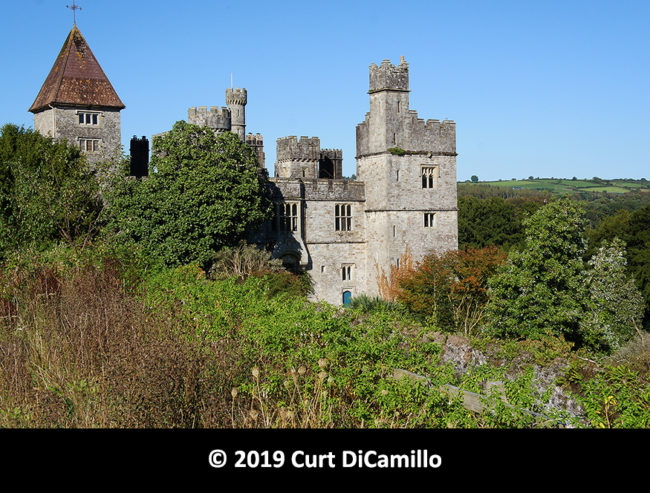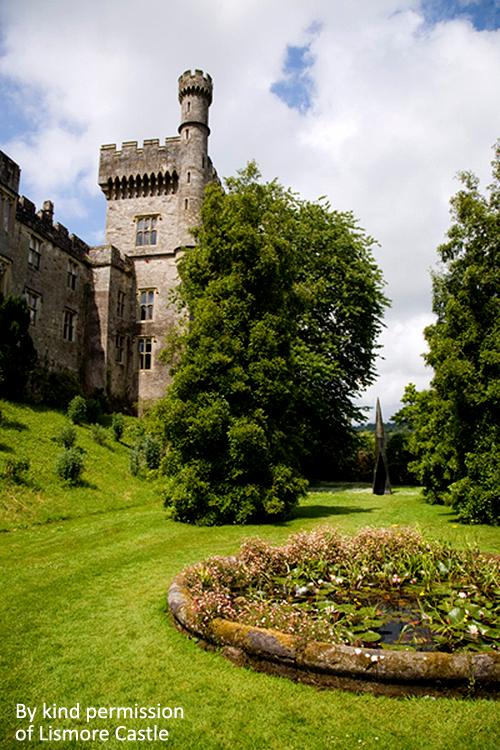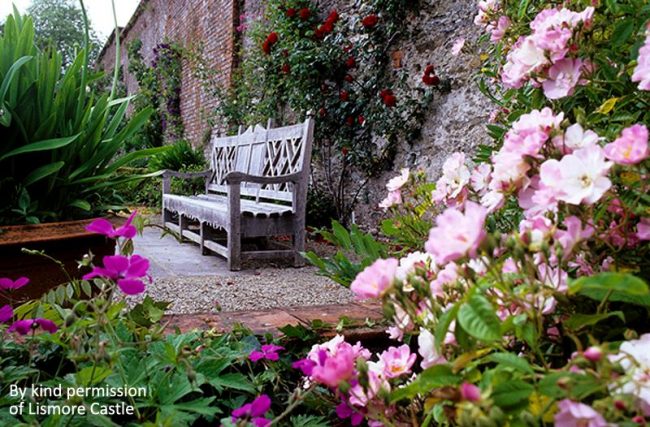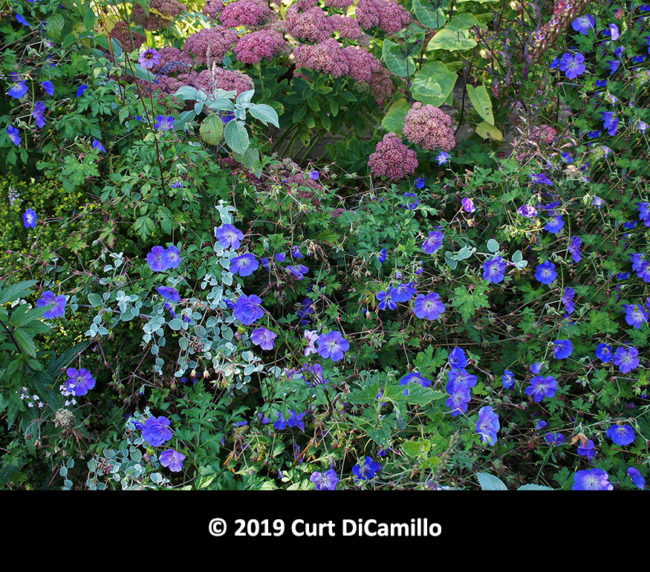
The castle from a circa 1905 postcard

The castle

The castle from the lower garden

The Ellis O'Connell Sculpture

The upper garden

The upper garden

The upper garden

The upper garden

The upper garden

The upper garden

Lismore Cathedral (formally St. Carthage Cathedral, Church of Ireland) from the upper garden

The upper garden

Bust of the gardener in the upper garden
Earlier Houses: The site of today’s castle was originally occupied by Lismore Abbey, an important 7th century monastery (King Henry II of England stayed at the abbey in 1171). In 1185, Prince John, Henry II’s youngest son, built Ardfinnan Castle here to guard the river crossing; this castle later became a medieval seat of the bishops of Waterford.
House & Family History: Lismore’s beginnings as one of the grandest castles in Ireland started in 1602, when Sir Walter Raleigh (who was in prison for high treason at the time) sold Lismore to Richard Boyle (created 1st Earl of Cork in 1620). Boyle purchased a ruinous castle, which he lavishly restored; most of this was lost in 1645, when large portions of Lismore were destroyed during the English Civil War (it was later rebuilt). It was at Lismore that the 1st Earl of Cork’s fourteenth child, Robert Boyle, was born in 1626. Robert became the father of modern chemistry. Lismore came to the Cavendish family (dukes of Devonshire, who still own it today) in 1753 through the marriage of the 4th Duke of Devonshire to the heiress (Lady Charlotte Boyle) of the 3rd Earl of Burlington and 4th Earl of Cork. In the 19th century the 6th Duke of Devonshire did enormous work on Lismore, enlarging the castle on a grand scale. The 6th Duke employed some of the 19th century’s finest architects and interior designers to rebuild Lismore as a Gothic fantasy: William Atkinson, Joseph Paxton, A.W.N. Pugin, and the Craces. In 1932 Adele Astaire, the famous sister of Fred Astaire, retired from the stage to marry Lord Charles Arthur Francis Cavendish, second son of the 9th Duke of Devonshire. The newlyweds moved to Ireland, where they lived at Lismore until Lord Charles's death in 1944. Adele continued to use the castle until shortly before her own death in 1981.
Garden & Outbuildings: The historic seven acres of gardens at Lismore are divided into two very different halves. The upper garden is a complete example of the 17th century walled garden first constructed here by Richard Boyle, 1st Earl of Cork, in about 1605. The outer walls and terraces remain and the plantings have changed to match the tastes of those living within the castle. The lower garden was mostly made in the 19th century for the 6th Duke of Devonshire, Joseph Paxton's patron. This garden is informal with shrubs, trees and lawns. The stately yew avenue is where Edmund Spencer is said to have written "The Faerie Queen" in 1589. This avenue is much older than the garden itself, probably 17th century. Camellias are the first heralds of spring, and are followed closely by the Magnolias and spring flowering bulbs. A fine collection of rhododendrons maintain the interest through late spring and early summer before giving way to the flowering herbaceous borders. The upper garden is home to herbaceous borders and a working kitchen garden providing vegetables, fruit and herbs for the castle kitchens. Vegetable beds are edged with roses and grass paths adding a decorative interest to the functional space. Key flowers and plants in the gardens are identified by hanging letters and the corresponding information is on the back of this leaflet. Since 1999, several pieces of contemporary sculpture have been installed in the gardens, including one by Anthony Gormley, best known for "Angel of the North," which overlooks the motorway at Gateshead in the north of England. Visitors can also visit the contemporary art gallery, Lismore Castle Arts, as part of their admission, which features exhibitions by some of the world's leading artists. (We are most grateful to Lismore Castle for this history of the gardens).
Architect: Augustus Welby Northmore Pugin
Date: 1850sArchitect: William Atkinson
Date: 1811John Bernard (J.B.) Burke, published under the title of A Visitation of the Seats and Arms of the Noblemen and Gentlemen of Great Britain and Ireland, among other titles: 2.S. Vol. II, p. 42, 1855.
John Preston (J.P.) Neale, published under the title of Views of the Seats of Noblemen and Gentlemen in England, Wales, Scotland, and Ireland, among other titles: Vol. VI, 1823.
Country Life: Mark Girouard in CXXXVI, 336, 389, 1964.
Title: Biographical Dictionary of British Architects, 1600-1840, A - SOFTBACK
Author: Colvin, Howard
Year Published: 1995
Publisher: New Haven: Yale University Press
ISBN: 0300072074
Book Type: Softback
Title: Hardwick Hall Guidebook
Author: Girouard, Mark
Year Published: 1996
Publisher: London: The National Trust
ISBN: 0707800986
Book Type: Softback
House Listed: Unknown
Park Listed: Unknown
Current Seat / Home of: Peregrine Andrew Morny Cavendish, 12th Duke of Devonshire; Cavendish family here since 1753.
Past Seat / Home of: Gerald FitzGerald, 15th Earl of Desmond, 16th century. Sir Walter Raleigh, 1589-1602. Richard Boyle, 1st Earl of Cork, 1602-43; Richard Boyle, 3rd Earl of Burlington and 4th Earl of Cork, 18th century. William George Spencer Cavendish, 6th Duke of Devonshire, 19th century; Lord and Lady Charles Arthur Francis Cavendish, 1932-44.
Current Ownership Type: Individual / Family Trust
Primary Current Ownership Use: Private Home
Ownership Details: Owned by Trustees of the Lismore Estate.
House Open to Public: Grounds Only
Phone: 3535-854-061
Fax: 3535-854-896
Email: [email protected]
Website: http://www.lismorecastlegardens.com
Historic Houses Member: No